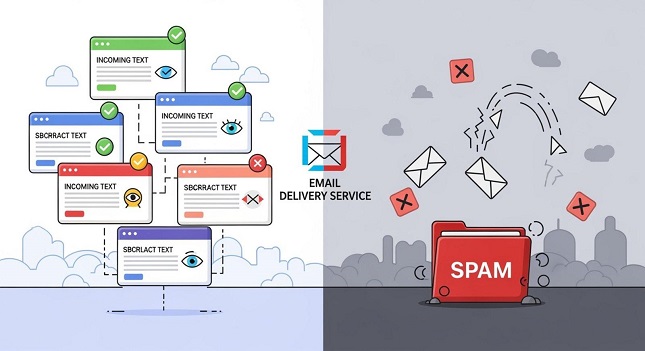Maintaining your brand’s email reputation is extremely important in today’s online environment. Email delivery services play a key role in making sure your emails get from your server to your recipients’ inboxes.
Their job is to handle the many technical aspects like email protocols, spam filters, and sender reputation scores so your emails arrive where you want them.
Without a trustworthy email delivery service, a company runs the risk of hurting its reputation, which can cause emails to end up marked as spam or blocked, making it harder to communicate and market to your audience.
Imagine you write the ideal email, with helpful information and a strong call to action. You send it, but then you get no response.
Was it sent to the inbox? Did it go to spam? Was it even accepted by the mailbox provider? This kind of uncertainty is what email delivery services aim to fix.
By taking care of the complicated parts of sending lots of emails, these services let companies focus on creating good messages and building relationships with subscribers, while knowing that their emails have a better chance to be delivered.
For businesses that want to make sure their emails are reliably delivered and maintain a strong reputation, using a proven platform like EmailLabs is an important step in protecting their email reputation.
What Do Email Delivery Services Do?
Email delivery services are tools or systems that make it easier to send emails, especially in large amounts. While regular email clients work for single messages, sending emails to hundreds or thousands of people calls for a dedicated approach. These services offer the servers, IP addresses, and technical systems needed to send big batches of emails in a reliable way.
They act as a go-between for your website or email marketing tool and the recipients’ email providers. Their main purpose is to make sure your emails are accepted and delivered to the right addresses. This involves following rules set by the providers, doing proper email setup, and keeping an eye on delivery to keep a good sender reputation.
Email Delivery vs. Email Deliverability
It’s easy to mix up these two terms, but they mean different things.
Email delivery is when your message is accepted by a mailbox provider (like Gmail, Yahoo, or Outlook). In other words, the server agreed to take your email.
Email deliverability is about whether the email makes it into the main inbox instead of getting sorted into a spam or promo folder.
As explained by some experts, delivery means your message is received by your contact’s provider; deliverability means it ends up where it’s actually seen-inside the inbox. Good deliverability is what companies really aim for.
How Email Delivery Works
Sending an email with a professional delivery service is more complicated than clicking “send.” The email is taken through their system, which may use its own IP addresses and checks for proper authentication, like SPF, DKIM, and DMARC.
The service also contacts different mailbox providers to follow their rules and spots any problems, such as undelivered messages or getting blacklisted.
The system will also handle things like email bounces, requests to unsubscribe, and provide reports on how your emails performed. This technical process is how companies can send emails to large groups without losing messages in the process.
Why Businesses Use Professional Email Delivery Services
Standard email setups are risky for bulk marketing or transactional emails. Professional services offer several clear benefits:
- They can handle high volumes easily and reliably.
- They have the technical knowledge to deal with all the rules mailbox providers set, improving the chance emails go to the inbox.
- They help protect your sending reputation by handling authentication, monitoring delivery, and providing tools to catch and fix problems.
By outsourcing this part of email management, businesses can increase delivery rates, get better audience engagement, and improve their email marketing results. It’s not realistic for most companies to handle this level of detail on their own.
Why Is Email Reputation Important for Your Brand?
Your email reputation is basically a score that shows if mailbox providers trust you as a sender. This judgment is made using your sending history and how people interact with your emails. A high reputation means providers think you’re a genuine sender, so your emails are more likely to be delivered. A poor reputation, though, gets your emails sent to spam or blocked.
In a crowded inbox, a strong sender reputation ensures that your emails are seen, opened, and acted on. Protecting this reputation isn’t just about following technical steps-it’s also important for keeping customer trust and communicating well with your audience.
Impact on Inbox Placement and Campaign Performance
Your reputation directly affects whether emails reach the inbox. Email services check your reputation to see if you’re trustworthy. Having a bad reputation can send your emails to spam or get them blocked, even if your message is good.
Poor inbox placement means fewer people open your emails, click your links, or buy your products, which makes your efforts less effective. Ideally, companies should reach a deliverability rate of at least 98-99% for best results.
How Sender Reputation Influences Trust
Your sender reputation also helps build trust with your audience. If your emails always show up in their inbox, people see you as a reliable source.
If your emails are flagged as spam or are hard to unsubscribe from, people will lose confidence in your brand, which can harm your reputation and lower engagement in the future. Having a strong sender reputation shows that you use good practices and helps keep relationships strong.
ROI Risks from a Damaged Email Reputation
Email marketing often delivers a good return on investment (ROI). But this only works if your emails actually make it to the inbox.
If your sender reputation drops, your emails won’t reach people, making your marketing budget less effective and causing you to miss out on potential sales. A damaged reputation can cost you both money and business opportunities.
What Factors Affect Your Email Reputation?
Your email reputation changes based on your email habits and how your contacts respond. Knowing what affects it helps you take action to keep and improve your reputation. Several things play a part, like technical setup, the quality of your email list, the kinds of messages you send, and how people react to your emails.
Keeping a good reputation means working on both the setup of your emails and the experience of your subscribers. If you ignore any part, your reputation can quickly fall.
Sender Score and Domain Reputation
Mailbox providers look at two main things:
- Sender score: A number rating given by services (like Validity) based on your sending habits, bounce rates, complaints, and if you’re on blocklists. It lets you compare your reputation to others.
- Domain reputation: Connected to your website address, it’s becoming more important as providers focus on domain-based scores. It looks at the quality of your emails and how people engage with them.
Both are important for getting your emails into inboxes.

Email Authentication Protocols: SPF, DKIM, DMARC
Using protocols like SPF, DKIM, and DMARC shows providers your emails are real and have not been tampered with. These tools:
- SPF lets you say which IP addresses can send emails for your domain.
example.com IN TXT “v=spf1 include:_spf.example.com ip4:192.0.2.0/24 ~all”
- DKIM adds a digital signature to confirm the email’s content.
mail._domainkey IN TXT “v=DKIM1; k=rsa; p=MIGfMA0GCSqGSIb3DQEBAQUAA4GNADCBiQKBgQDy…IDAQAB”
- DMARC builds on SPF and DKIM, telling receiving servers how to handle emails that fail checks and giving you reports.
_dmarc.example.com IN TXT “v=DMARC1; p=quarantine; rua=mailto:dmarc_reports@example.com; ruf=mailto:dmarc_forensics@example.com; fo=1”
These need to be set up correctly to keep your sender reputation strong.
List Quality and Engagement
Having a good email list is critical. If you send to addresses that don’t exist or aren’t used, your bounce rates rise and you could hit spam traps, which damages your reputation. Positive engagement-opens, clicks, and replies-tells providers that people value your emails. Sending to engaged, valid lists keeps your sending reputation healthy.
Email Content and Formatting
Though spam filters are less strict on specific “trigger words,” your content still matters. Providers watch for emails with too many capital letters, exclamation points, or suspicious links.
If your emails are not well-put-together or are irrelevant, people are less likely to interact, which also hurts your reputation. Your focus should be on sending useful, well-designed content that your audience wants.
Sending Volume and Consistency
The amount of emails you send, as well as how often, matters a lot. If you suddenly start sending many more emails, especially from a new IP, providers can get suspicious. That’s why IP warming, where you slowly increase your sending numbers, is needed. Keeping a regular schedule also shows consistency and helps you build trust with mailbox providers.
Spam Complaints and Feedback Loops
Spam complaints quickly hurt your reputation. If too many people mark your message as spam, providers are more likely to filter or block your emails. Signing up for feedback loops (where providers let you know if your emails are marked as spam) means you can remove unhappy contacts right away and avoid more complaints.
How to Monitor and Measure Email Delivery Performance
To keep your reputation and deliverability high, you need to keep a regular watch on your results. Tracking important metrics will help you spot problems early and fix them before they become bigger issues. Using the following tools and indicators can keep you informed and in control.
Key Email Delivery Metrics: Delivery Rate, Open Rate, Bounce Rate
| Metric | What It Shows |
| Delivery Rate | What percentage of your emails were accepted by servers |
| Open Rate | Percentage of people who opened your email |
| Bounce Rate | Percentage of emails that could not be delivered |
| CTR (Click-Through Rate) | Percent who clicked a link in your email |
| Spam Complaint Rate | Rate at which emails are marked as spam |
| Unsubscribe Rate | How many recipients opt out after an email |
| Inbox Placement Rate | How many emails landed in the main inbox folder |
Watching these over time helps you see patterns and catch issues quickly.
How to Check Your Sender and Domain Reputation
There are tools to check your sender and domain reputation. Validity’s Sender Score, Google Postmaster Tools (for Gmail), Yahoo Feedback Loop, and Microsoft SNDS (for Outlook/Hotmail) help you monitor your reputation and spot trouble areas.
Detecting Spam Trap Issues and Blocklistings
Getting caught in a spam trap or landing on a blocklist badly hurts deliverability. Spam traps identify senders who don’t manage lists well, and blocklists tag IPs and domains linked with spam. Check major blocklists like Spamhaus, Spamcop, and Barracuda often. If you find yourself on one, you need to fix the root problem, clean your list, and follow each blocklist’s instructions for removal right away.
Best Practices for Protecting Your Brand’s Email Reputation
Building and keeping a good email reputation takes regular work. By following proven practices, you show providers that you are a responsible sender, improving your chances of reaching people’s inboxes and keeping your audience engaged and happy.
List Hygiene: Cleaning and Managing Subscribers
- Remove hard bounces (undeliverable emails) immediately.
- Use a “sunset policy” to unsubscribe users who haven’t interacted with you for a set period.
- Avoid buying or renting email lists, since they often include spam traps or bad addresses and can break privacy laws.
Double Opt-In and Permission Management
- Use double opt-in: make subscribers confirm their signup by clicking a link before adding them to your list. This keeps your list accurate and engaged.
- Make your privacy policy clear and let people manage their preferences easily.
Content Personalization and Segmentation
- Personalize emails and segment your list so messages match subscribers’ interests. This encourages higher engagement and tells providers your messages are wanted.
Red Flags: Avoiding Spam Trigger Words and Poor Formatting
- Use clear, simple, professional language. Avoid lots of capital letters, too many exclamation points, or suspicious links.
- Use clean HTML formatting for your emails.
Volume Control and IP Warming
- If using a new IP, start with small volumes and slowly build up (IP warming) so providers don’t get suspicious and block your emails.
- Keep to a regular schedule to build trust.
Providing Easy Unsubscribe Options
- Always include a clear unsubscribe link.
<a href=”https://yourdomain.com/unsubscribe/{{user_id}}”>Unsubscribe</a>
Making it hard to opt out increases spam complaints, which hurts your reputation more than losing a few subscribers.
How to Recover from Deliverability Issues
Sometimes, even with good practices, your email deliverability can drop. If emails start going to spam or you notice less engagement, you’ll need a plan to fix things and recover your reputation.
Diagnosing Reputation Drops and Delivery Failures
- Watch your open, bounce, and complaint rates.
- Use tools from Google, Yahoo, and Microsoft to check your standing.
- Check blocklists to see if your domain or IP has been flagged.
- Review your sending history and email set up (SPF, DKIM, DMARC).
Removing Your Domain from Blocklists
- Follow each blocklist’s specific delisting rules. Clean up your lists, fix volume issues, and make sure your authentication is right before requesting removal.
Rebuilding Trust with Internet Service Providers
- Focus on sending to your most engaged subscribers at first.
- Slowly increase send volume as things improve.
- Be consistent and monitor metrics closely; remove people who mark you as spam right away.
Choosing an Email Delivery Service to Safeguard Your Brand
Given how many rules there are and how much your reputation matters, it’s a smart move for most businesses to pick a trusted email delivery service. The right service will give you the tools and support you need for strong deliverability and brand protection.
Comparing Service Features: Deliverability Tools, Filtering, and Monitoring
- Choose services that offer reliable deliverability features, like testing before send, inbox placement checks, and detailed reports after sends.
- Look for strong filtering, feedback loops, and the ability to track important metrics such as delivery, bounces, spam complaints, and clicks.
Role of Dedicated vs. Shared IP Addresses
- With shared IPs, multiple senders use the same address. Good for low-volume senders; mistakes are balanced out by other users’ good habits.
- Dedicated IPs are used only by your business. Better for high-volume senders who can manage their own reputation well.
| IP Type | Good For | Main Benefit | Main Risk |
| Shared | Smaller senders | Shared reputation; easier entry | Other senders can impact your results |
| Dedicated | High-volume/experienced senders | Full control of reputation | You carry all reputation risk |
Integrating Advanced Analytics and Automation
- Pick a service with helpful analytics to see how your audience interacts.
- Automation, such as automatic list cleaning, re-engagement, and triggers based on user behavior, helps ensure good deliverability and saves time.
- Access to monitoring, deliverability tests, and blocklist checks adds further peace of mind.









































